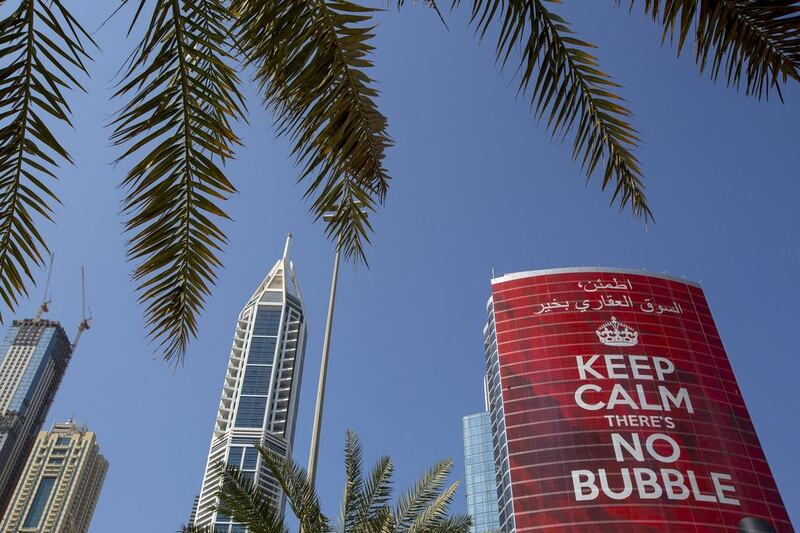Analysts spent hours and pages discussing whether the Dubai housing market was experiencing one, and if it was would it pop, leading to the same sort of crisis that occurred in 2008?
Although the office and warehousing markets remained relatively subdued, house prices in the emirate rose alarmingly sharply during the year.
After crashing by as much as 60 per cent during the global financial crisis then bottoming out and starting to rise again last year, Dubai house prices rocketed in 2013.
According to the property broker Knight Frank, prices for prime property in the city rose faster than anywhere in the world during the first half of the year, soaring 14.7 per cent during the period and by 5 per cent between April and June alone.
Rising property prices were accompanied by scenes of hundreds of people queuing in the heat 48 hours before an Emaar property launch in February and confrontations on the sidelines of the Cityscape property show in October as potential investors attempted to get their hands on off-plan flats.
The surge also led to increased warnings about so called “flipping”, in which traders buy up sales and purchase agreements on flats that are yet to be built, only to sell them on again soon afterwards at a steep profit, in turn fuelling house price inflation.
Rents too, which had started to increase in 2012, were spiralling out of control in Dubai as landlords sought to take advantage of rising prices.
Landlords in some locations increased rents for vacant apartments by as much as 40 per cent. And lawyers reported an outbreak of rent disputes between landlords and tenants as the latter complained that they were being asked to pay more than the cap set by Dubai Land Department, prompting the emirate’s Government to open a new rent dispute body to cope with demand.
Even Abu Dhabi, suffering from an oversupply of housing built during the global financial crisis, started to experience some increases in house prices and rents, although these were generally limited to the capital’s new master planned areas. Soon Cluttons, the property broker, was reporting price increases of 11.2 per cent during the second quarter and 14.4 per cent in the three months to the end of September, while rents rose 4.5 per cent then 1 per cent over the same periods.
The problem was, as tenants vehemently asserted, that although property prices and rents were rising rapidly, the fundamentals usually behind such rises, wages and population numbers were not.
According to the recruitment company Hay, despite the rapidly increasing cost of living, basic salaries grew by an average of just 4.4 per cent over the year – down from 4.9 per cent the previous year. And Jones Lang LaSalle estimates the population of Dubai grew about 5 per cent over the same 12 months.
As prices and rents continued to rise unsustainably, the warning bells rang ever louder.
In June, the IMF cautioned during its annual mission to the UAE that rising optimism about property prices and easier access to global liquidity could prompt a renewed cycle of risk-taking that could “fuel short-term growth at the expense of medium-term stability”.
And in August the Dubai Land Department announced it would be introducing seven laws aimed at better regulating the property market and attempting to ward off speculators.
In September, the first of these was introduced, a move to double the transfer fee – a tax levied by the Dubai Government on all property sales – from 2 to 4 per cent of a property’s value.
Then in October the Central Bank finally issued long-awaited regulations capping the amount of money that homeowners were allowed to borrow to between 60 and 80 per cent of a property’s value in an attempt to further cool the Dubai housing market.
By the end of the year it looked as though the new measures had started to take effect and the Dubai housing bubble was starting to slowly subside.
According to Cluttons, average house prices in Dubai rose by just 8 per cent in the third quarter of the year, down from the dramatic 23 per cent growth the company had reported the previous quarter.
Rent rises too, the broker reported, were starting to slow, with average rents rising by 3 per cent during the third quarter of the year, down from 8 per cent the previous quarter.
It looked as though the dreaded bubble had been safely averted.
But then on November 27, everything went back to square one when the Bureau International des Expositions announced it had awarded Dubai the right to host Expo 2020 – an event predicted to add 2 per cent to the emirate’s GDP as well as to create 277,000 jobs.
Dubai developers, who had been quietly building up billions of dirhams worth of land around the planned Expo site, hastened their housing plans and a new wave of house buying and speculation looked like it was on the cards as property brokers again warned that the boosted sentiment could lead to an unsustainable bubble in the real estate sector.
And so the year ends, much as it started, with the markets again speculating whether the UAE has finally reached its goal of achieving a sustainable (albeit fast) growing housing market or whether we will remain forever blowing bubbles.
lbarnard@thenational.ae





